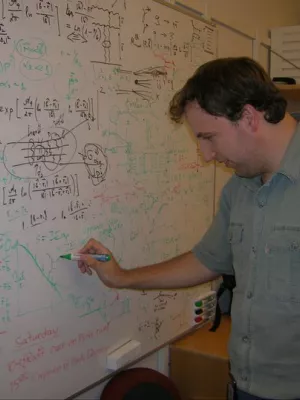
Roman Pasechnik
Senior lecturer

Mirror symmetry of quantum Yang–Mills vacua and cosmological implications
Author
Summary, in English
We find an argument related to the existence of a Z
2
-symmetry for the renormalization group flow derived from the bare Yang–Mills Lagrangian, and show that the cancellation of the vacuum energy may arise motivated both from the renormalization group flow solutions and the effective Yang–Mills action. In the framework of the effective Savvidy’s action, two Mirror minima are allowed, with exactly equal and hold opposite sign energy densities. At the cosmological level, we explore the stability of the electric and magnetic attractor solutions, both within and beyond the perturbation theory, and find that thanks to these latter the cancellation between the electric and the magnetic vacua components is achieved at macroscopic space and time separations. This implies the disappearance of the conformal anomaly in the classical limit of an effective Yang–Mills theory. In this picture, the tunneling probability from the Mirror vacua to the other vacua is exponentially suppressed in the quantum non-thermal state – similarly to what happens for electroweak instantonic tunneling solutions. Specifically, we show that, in a dynamical Friedmann–Lemaître–Robertson–Walker (FLRW) cosmological background, the Nielsen–Olsen argument – on the instability of uniform chromo-electric and chromo-magnetic Mirror vacua – is subtly violated. The chromo-magnetic and chromo-electric uniform vacua are unstable only at asymptotic times, but at those times the attractor to a zero energy density is already reached. The two vacua can safely decay into one anisotropic vacuum that has zero energy-density inside the Fermi confinement volume scale. We also discover a new surprising pattern of solitonic and anti-solitonic space-like solutions, which are sourced by the Yang–Mills dynamics coupled to the Einstein’s equations in FLRW. We dub such non-perturbative configurations, which are directly related to dynamical cancellation mechanism of the vacuum energy, as chronons, or χ-solutions.
Department/s
- Theoretical Particle Physics - Has been reorganised
Publishing year
2019
Language
English
Publication/Series
European Physical Journal C
Volume
79
Issue
3
Document type
Journal article
Publisher
Springer
Topic
- Subatomic Physics
Status
Published
ISBN/ISSN/Other
- ISSN: 1434-6044

